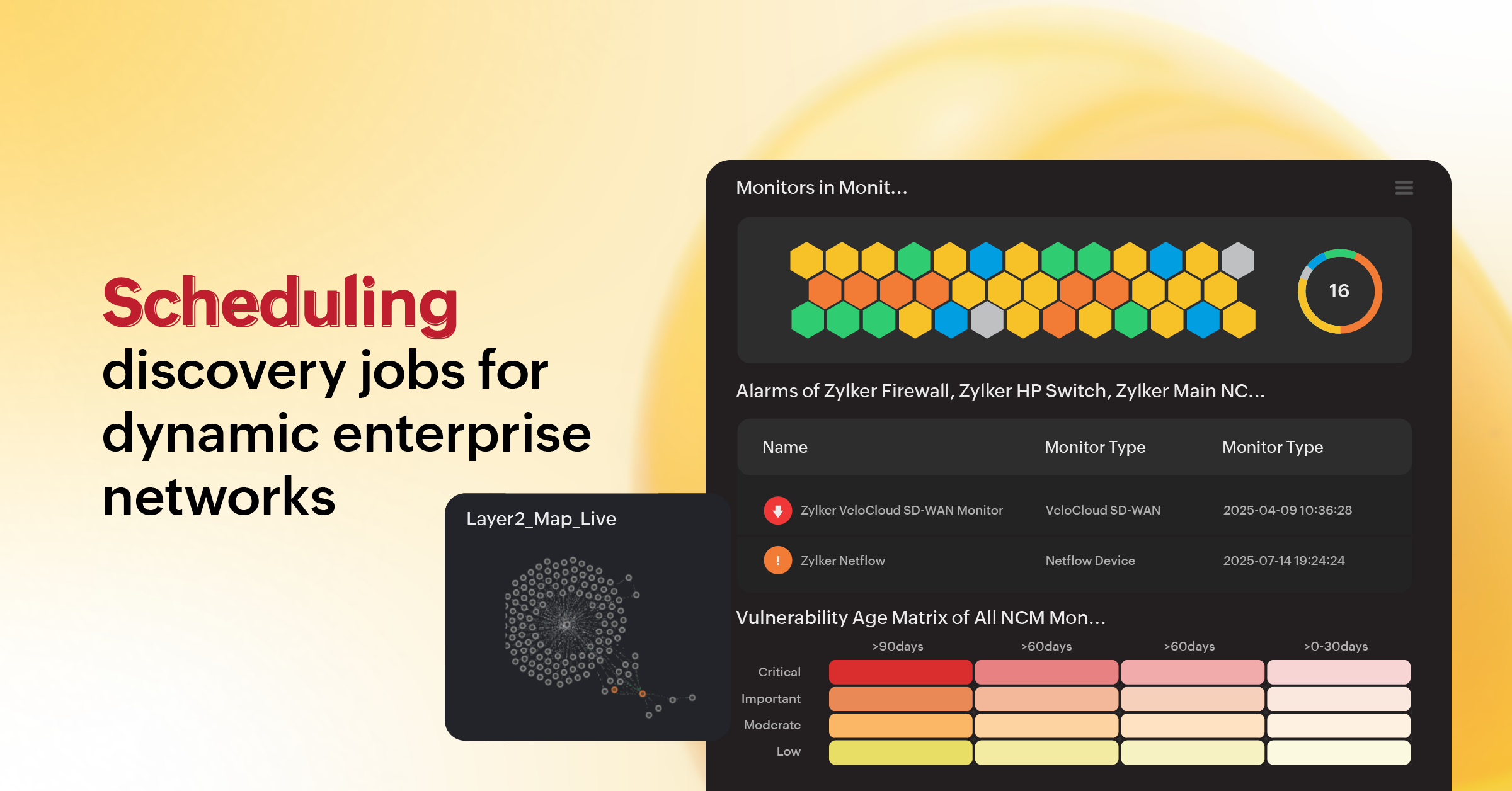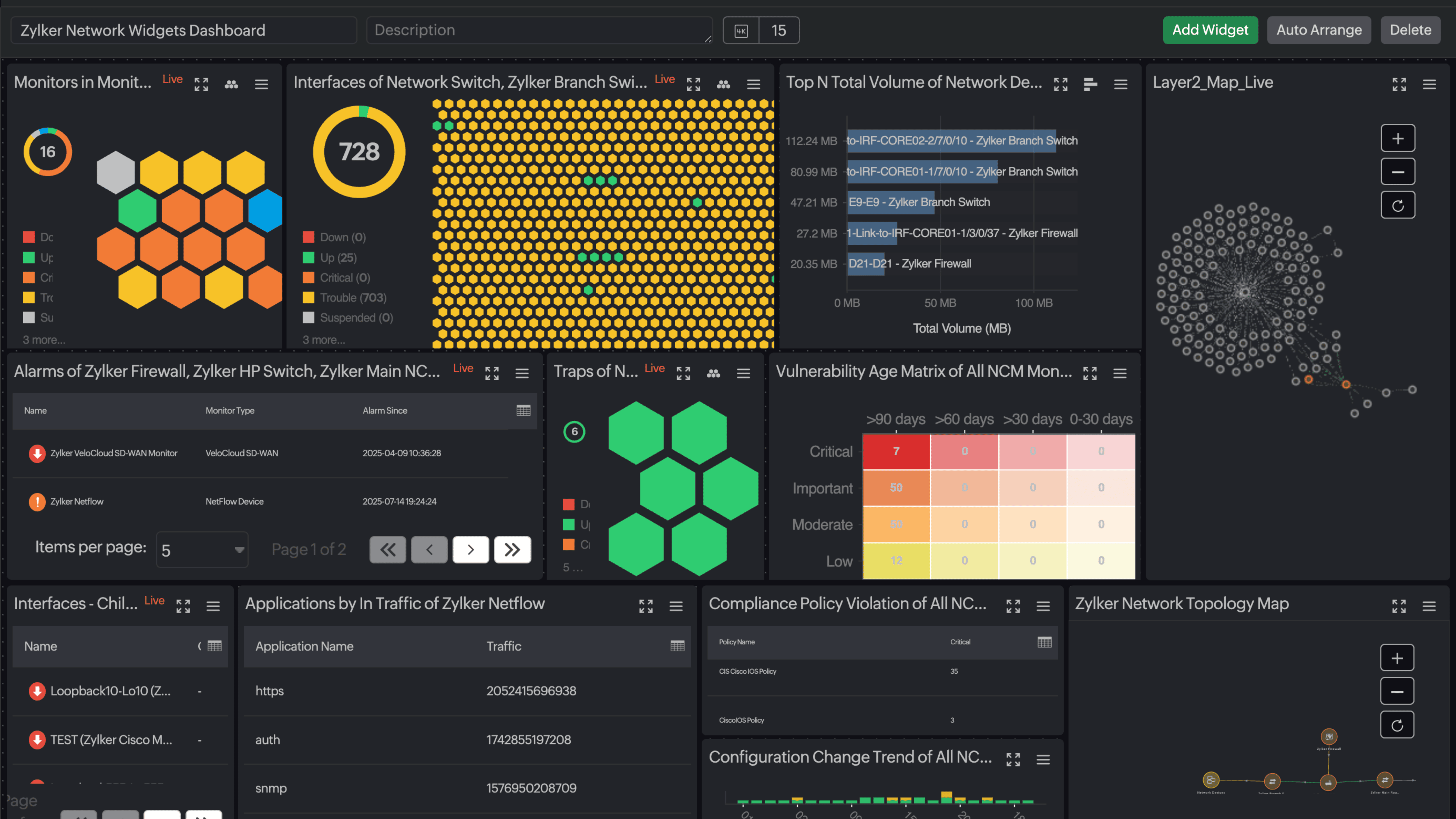Scheduling discovery jobs for dynamic enterprise networks
 Networks have evolved far beyond simple data conduits.They're now the backbone of decentralized digital enterprises, serving as critical channels for information exchange. Modern networks connect dispersed locations and devices, driving performance, security, and cost efficiency. However, decentralization also scatters assets, creates blind spots and increases operational complexity.
Networks have evolved far beyond simple data conduits.They're now the backbone of decentralized digital enterprises, serving as critical channels for information exchange. Modern networks connect dispersed locations and devices, driving performance, security, and cost efficiency. However, decentralization also scatters assets, creates blind spots and increases operational complexity.Site24x7 helps you tackle this challenge by automating device discovery across diverse network environments. Its scheduled network discovery scans subnets at regular intervals, instantly onboards new devices, updates configurations, and flags rogue endpoints. Incremental scans reduce bandwidth use, while smart filters and automated tagging keep your monitoring environment clean. With Site24x7, IT teams maintain accurate inventories without manual effort to ensure every branch, edge device, and cloud workload stays visible and monitored.

Decentralization creates blind spots
When different business units deploy resources independently, IT loses a single source of truth. A firewall upgrade at a branch office or a new virtual machine in the cloud can go unmonitored if it's not manually added to your monitoring tool. These blind spots affect uptime, expose vulnerabilities, trigger false alerts, or delay root cause analysis.
How scheduled discovery closes the gaps
Automating discovery jobs ensures your monitoring platform stays synchronized with real network activity:
- Maintains performance: Quickly detects new devices, interface changes, or bandwidth-heavy endpoints so you can address issues before they degrade service.
- Improves security: Flags unexpected or rogue devices as soon as they connect, reducing the risk of unauthorized access or compliance violations.
- Reduces cost: Eliminates wasted effort from manual inventory updates and minimizes downtime-related losses by keeping your device map current.
How scheduled network discovery works in Site24x7
Site24x7 lets you define discovery parameters and schedule scans at set intervals. For instance, you might run incremental scans every night and a full scan each weekend. Smart filtering excludes guest networks or temporary lab devices, ensuring your monitoring environment stays clean and relevant.
Incremental discovery is especially valuable in large deployments, as it scans only for changes since the last run, reducing bandwidth usage and scan time.
Real-world use cases
- Branch office growth
- Problem: A new branch office comes online overnight, but without an updated inventory, critical switches and firewalls might not be monitored by the time employees start work.
- How Site24x7 helps: Scheduled discovery scans automatically detect and onboard these devices, ensuring monitoring is active before the first login.
- Edge rollouts
- Problem: Dynamic devices are frequently added or redeployed in remote locations, creating gaps in visibility.
- How Site24x7 helps: Automated discovery through SNMP keeps your monitoring aligned with every new or relocated edge, so your topology and performance data remain accurate without manual updates.
- Frequent transitions
- Problem: Employees migrate between locations frequently, leaving your monitoring outdated and incomplete.
- How Site24x7 helps: Nightly incremental scans capture these changes in near real-time, maintaining a current device inventory for hybrid workforces.
- Security audits and compliance
- Problem: Manual inventory collection before a compliance audit consumes hours of IT resources and risks inaccuracies.
- How Site24x7 helps: Automated discovery instantly produces an up-to-date device inventory, providing auditors with reliable data while saving your team valuable time.
Best practices for scheduling discovery jobs
- Schedule intelligently: Balance bandwidth use with network size—daily incremental and weekly full scans are common.
- Use maintenance windows: Run full discoveries during off-peak hours to avoid network strain.
- Apply least privilege: Use read-only SNMP v2/v3 credentials for secure access.
- Tag devices on discovery: Automate tagging for easy grouping, alerting, and reporting.
- Review discovery logs: Monitor for unexpected or unauthorized devices.
Key takeaways on scheduling discovery for decentralized networks
As enterprise networks continue to decentralize, visibility becomes a moving target. Scheduled network discovery jobs provide the automation needed to maintain performance, strengthen security, and control operational costs. By ensuring your monitoring platform always reflects your network's real state, you can keep pace with business changes and prevent issues—no matter how distributed your infrastructure becomes.
Topic Participants
Rama Venkatesan